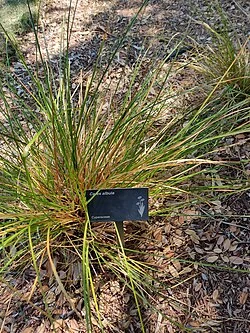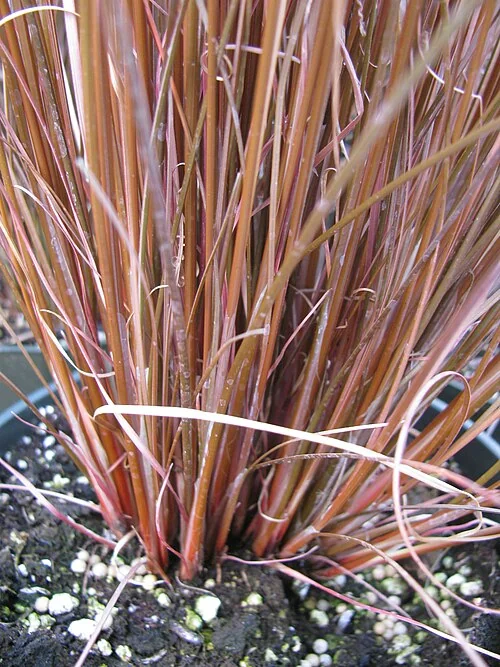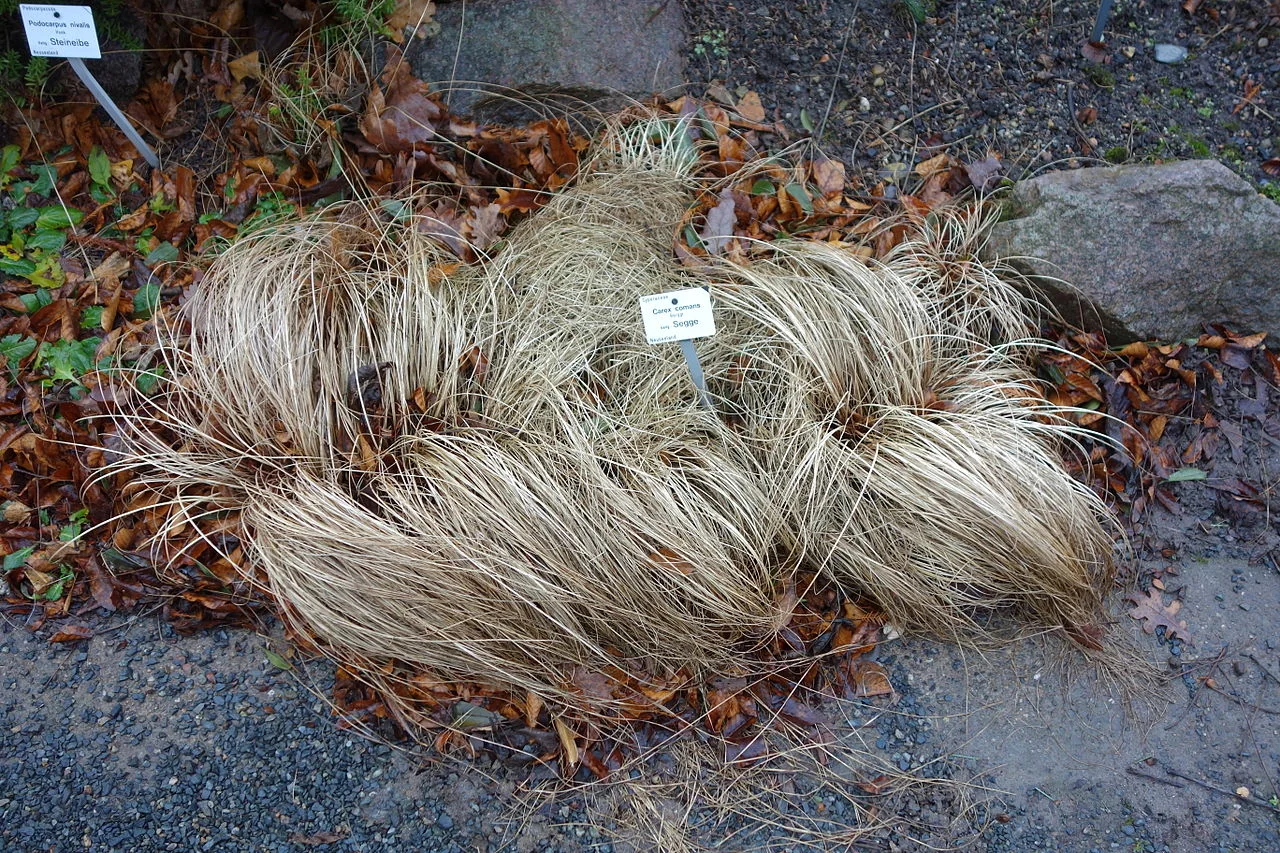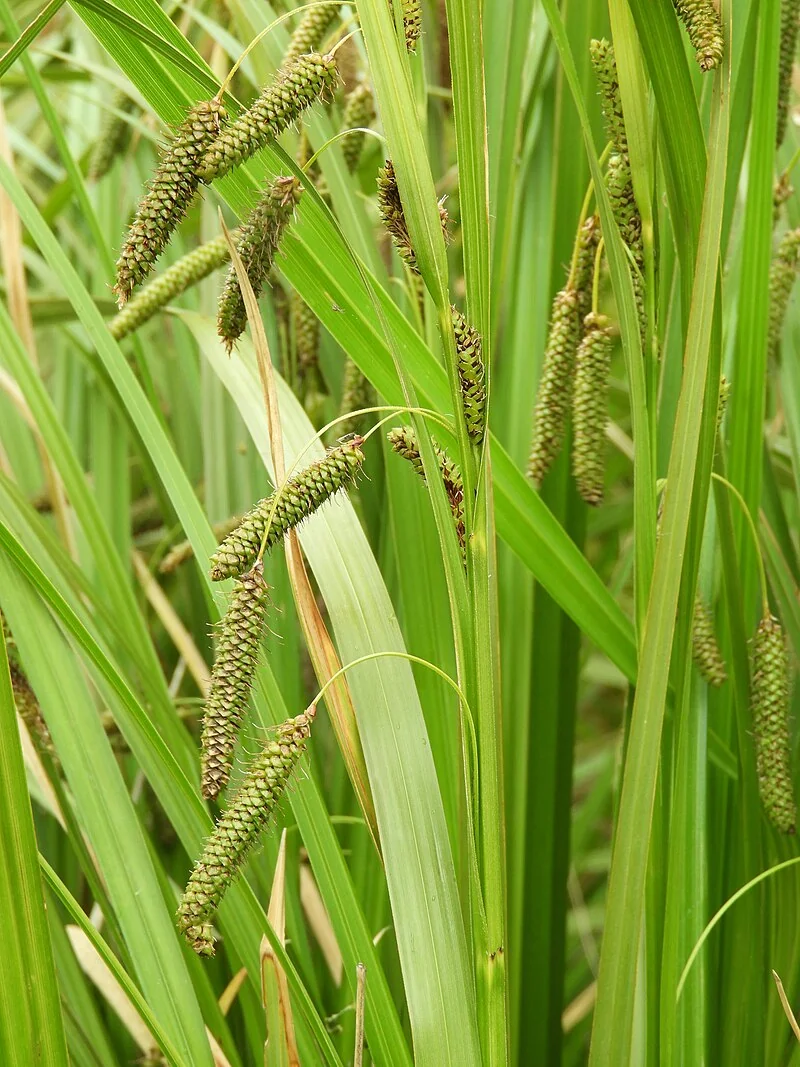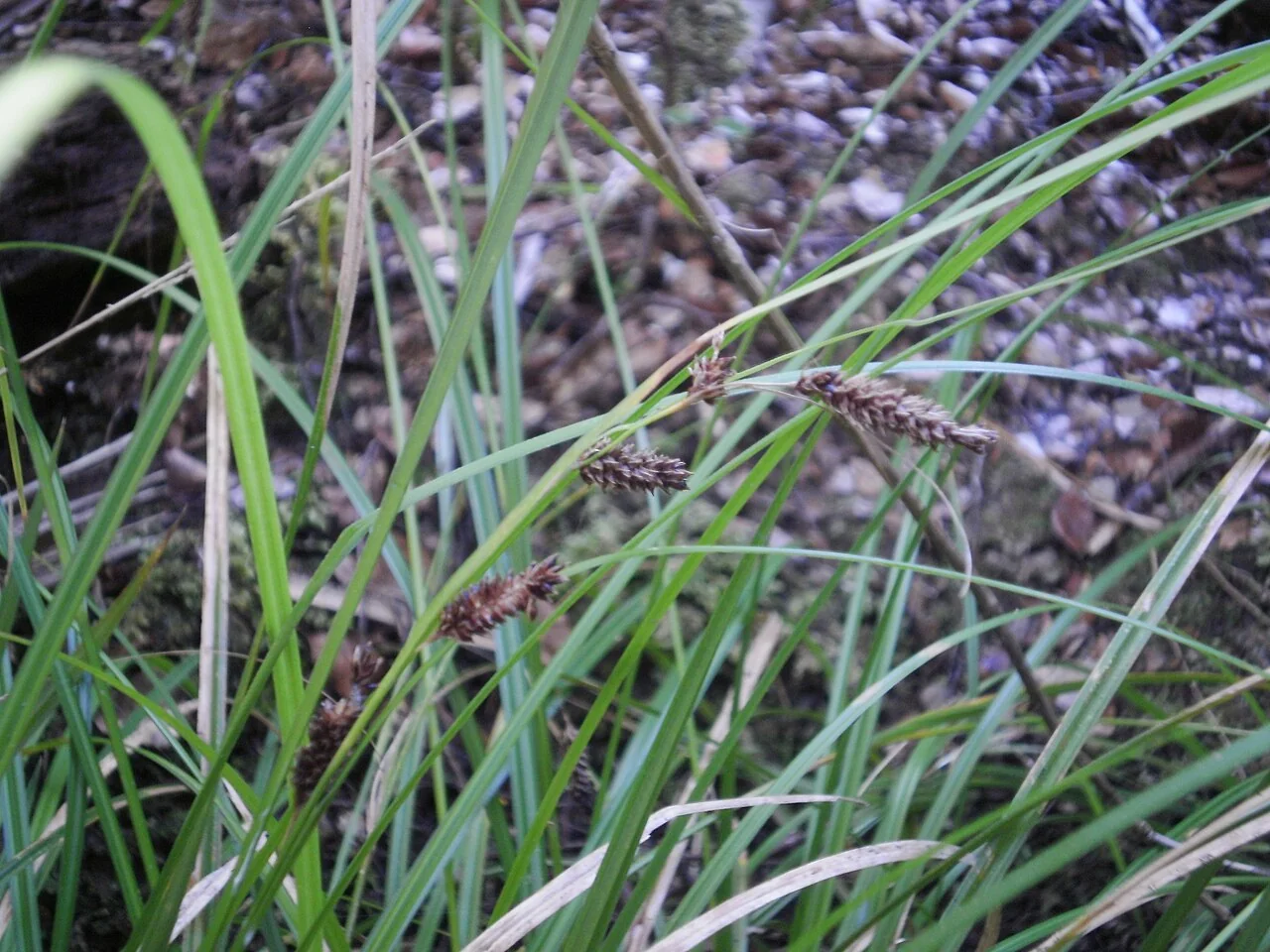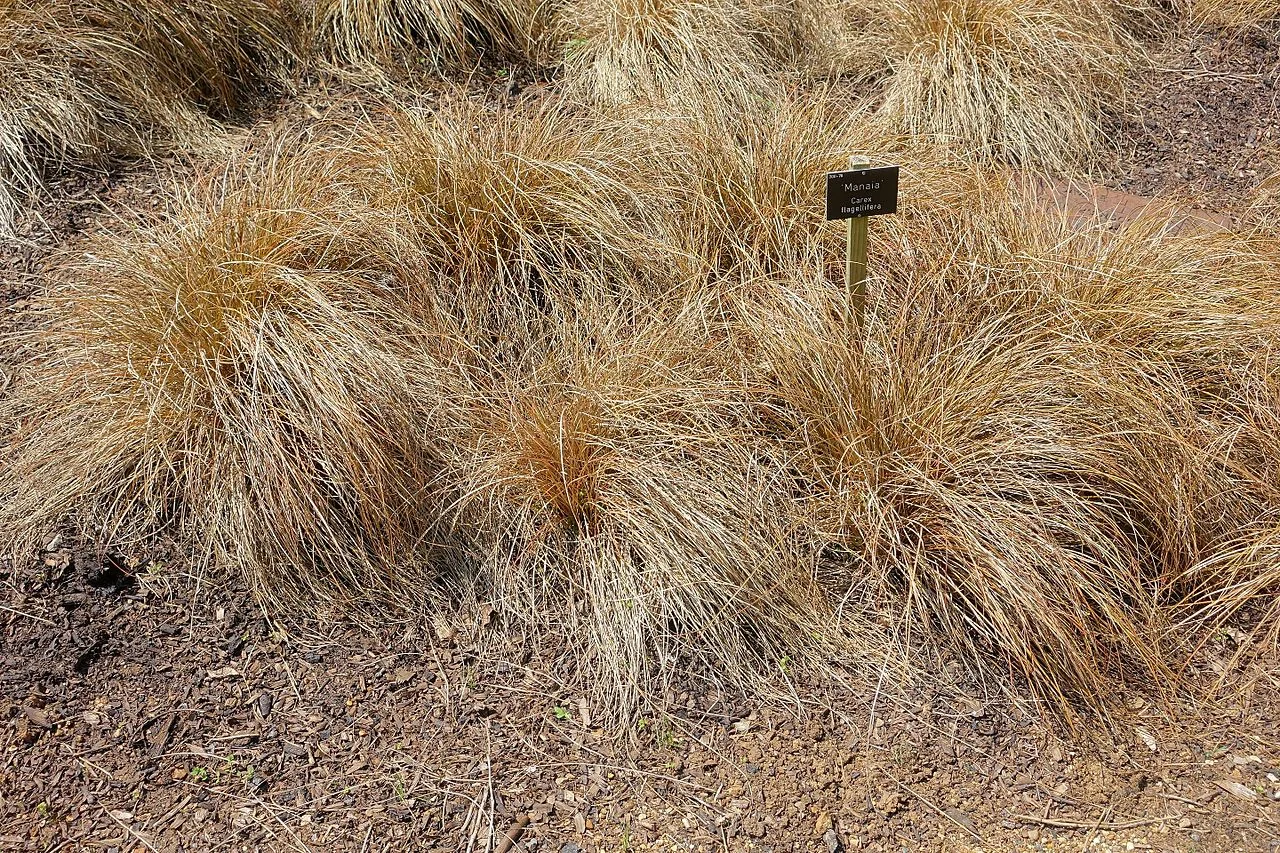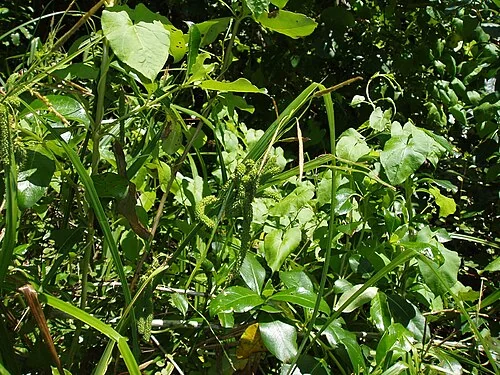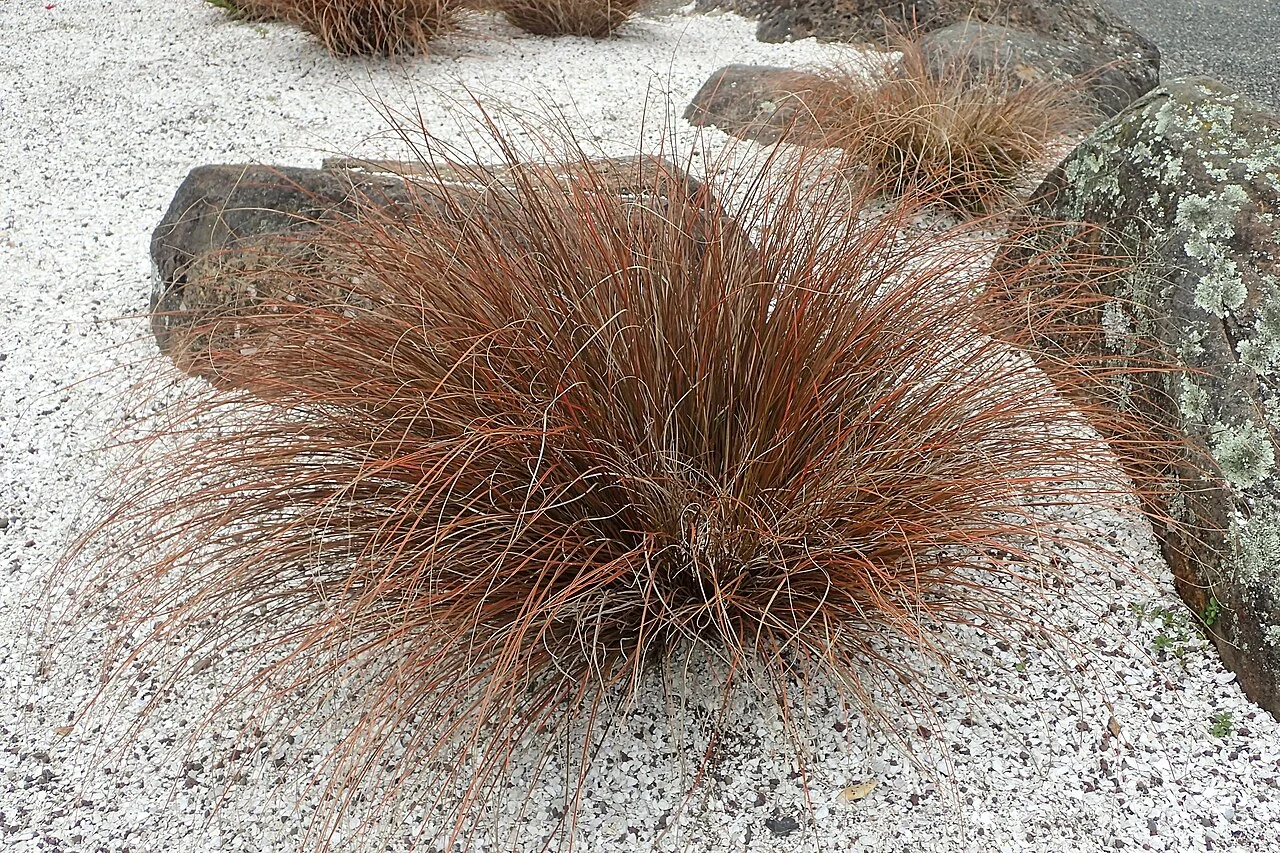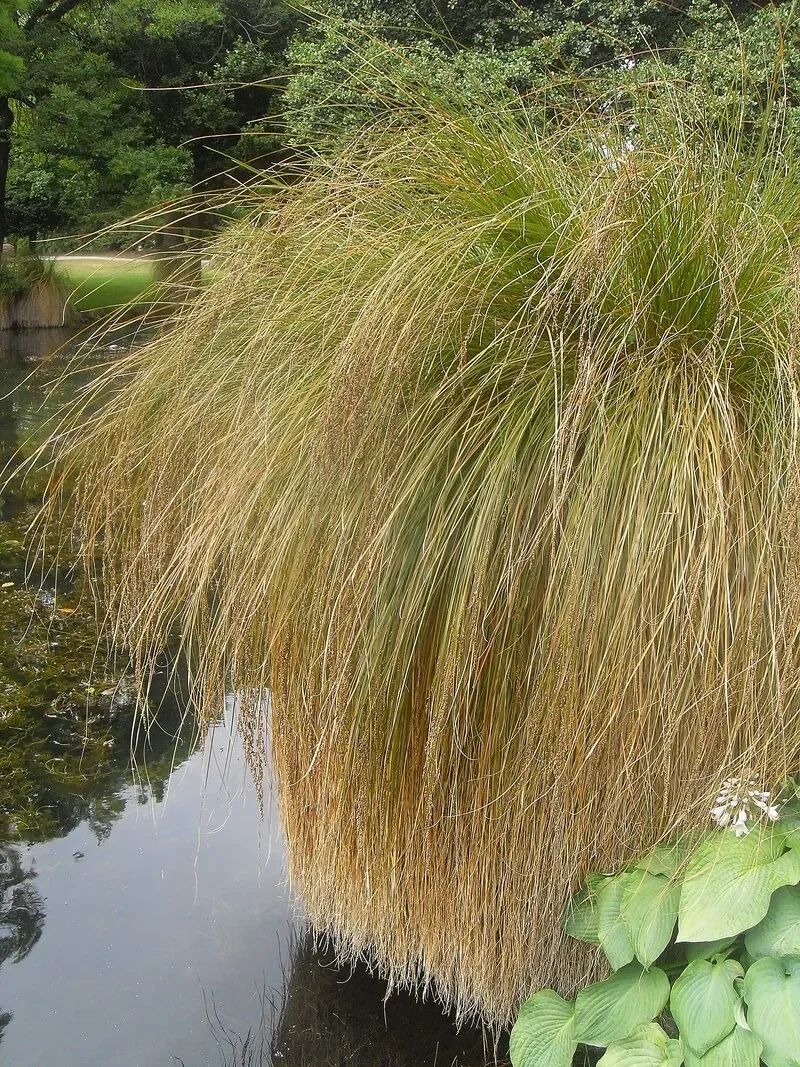
Pūrei
Carex secta
Explore more NZ native plant guides in our index .
Introduction
About Pūrei
Carex secta , known by its Māori names Pūrei, Makura, or Pūkio, is one of New Zealand's most culturally significant and ecologically distinctive sedges, representing a vital connection between traditional Māori knowledge and contemporary wetland restoration practices. This remarkable tussock-forming endemic species, found throughout the North, South, and Stewart Islands, creates one of nature's most extraordinary features: elevated "trunk-like" platforms up to 1.5 m tall formed from densely matted rhizomes, roots, and old leaf bases that rise like natural islands above wetland waters. Historically used by Māori for roof thatching due to its durable, water-resistant leaves, Pūrei holds special significance in traditional proverbs as "He pūreirei whakamatuatanga" - a faithful fatherly tuft that provides secure footing while crossing treacherous swamplands, symbolizing reliability and steadfast support in challenging environments.

Plant Description
Carex secta , known by its Māori names Pūrei, Makura, or Pūkio, is a distinctive native sedge endemic to New Zealand. It forms dense tussocks of grass-like leaves, typically dark green to yellow-green, and is renowned for developing elevated "trunk-like" bases up to 1.5 meters tall. These unique platforms are formed from densely matted rhizomes, old culms, and roots, rising like natural islands above wetland waters. It produces small, inconspicuous flowers on loosely branching, drooping panicles. This robust sedge thrives in wetland and riparian habitats, playing a crucial role in soil stabilization and providing habitat for wildlife.
Quick Facts
| Scientific Name | Carex Secta |
|---|---|
| Height | 15-20 m |
| Spread | 3-5 m |
| Water Needs | Moderate |
| Light | Full sun to part shade |
| Frost Tolerance | Moderate |
| Salt Tolerance | Moderate |
| Growth Rate | Medium |
| Lifespan | Long |
Climate Best Suited to
Carex secta demonstrates remarkable adaptability across New Zealand's diverse wetland environments, naturally occurring from coastal to montane zones throughout the North, South, and Stewart Islands where it forms characteristic tussock communities in suitable wetland sites. As an obligate wetland species, this hardy endemic thrives in permanently waterlogged conditions, preferring water depths of 10-30cm that provide optimal growing conditions. Its natural distribution across multiple climate zones reflects exceptional tolerance for New Zealand's temperate maritime conditions, from subtropical northern regions to the cooler southern environments, making it invaluable for wetland restoration projects throughout the country.
Regional Suitability
| City | Climate Suitability |
|---|---|
| Whangārei | Ideal |
| Auckland | Ideal |
| Hamilton | Ideal |
| Tauranga | Ideal |
| Rotorua | Ideal |
| Gisborne | Ideal |
| New Plymouth | Ideal |
| Napier | Ideal |
| Whanganui | Ideal |
| Palmerston North | Ideal |
| Wellington | Ideal |
| Nelson | Ideal |
| Christchurch | Ideal |
| Dunedin | Ideal |
| Invercargill | Ideal |
Habitat
Natural Distribution
Carex secta , known by its Māori names Pūrei, Makura, or Pūkio, is a native New Zealand sedge that thrives in wetland and riparian habitats. It is commonly found in swamps, bogs, and along the edges of streams, rivers, lakes, and ponds throughout the North, South, and Stewart Islands.
This species is exceptionally well-adapted to wet conditions and can tolerate saturated roots, even being waterlogged year-round. It prefers moist to wet soils, often organic or peaty soils found in wetlands. While it can grow in drier environments, its optimal growth occurs in water depths between 10 and 30 cm. Carex secta can be found from coastal to mountainous areas, typically up to 400 meters above sea level, and can tolerate a range of light conditions, from full sun to partial shade.
Plant Conservation
Carex secta is an endemic New Zealand sedge found throughout North, South, and Stewart Islands, having undergone assessment under the New Zealand Threat Classification System during the comprehensive 2022-2023 review of native vascular plant taxa. This culturally significant wetland species demonstrates wide distribution across diverse freshwater habitats from coastal to mountainous regions.
The species benefits from its adaptability to various wetland environments and its ability to tolerate saturated conditions year-round. Its unique growth form, creating elevated platforms above water levels, provides important microhabitat for wetland ecosystems and contributes to overall wetland stability and biodiversity.
Like many New Zealand wetland species, Pūrei faces challenges from wetland drainage, habitat modification, and competition from invasive plants. The species' dependence on permanently wet conditions makes it particularly vulnerable to changes in hydrology and water management practices that affect wetland water levels and seasonal flooding patterns.
Conservation efforts benefit significantly from the species' deep cultural significance as Pūrei in Māori tradition, including its role in traditional proverbs and practical applications for thatching. This cultural connection helps maintain awareness and support for wetland conservation, while the species' use in restoration projects and erosion control provides practical conservation outcomes. Its popularity in cultivation for water gardens and wetland restoration reduces collection pressure on wild populations.
Growing Requirements
Soil Requirements
White maire (Nestegis lanceolata) is remarkably adaptable to different soil conditions, thriving in well-drained environments. It can tolerate a variety of soil types, from sandy to loamy, and prefers a neutral to slightly acidic pH. Good drainage is crucial to prevent root rot, ensuring healthy growth and development.
- Tolerates a wide range of soil types from clay to sandy
- Prefers well-draining soils but can handle occasional waterlogging
- Thrives in moderately fertile soils but will grow in poor soils too
- Can tolerate slightly acidic to slightly alkaline pH
- Handles coastal conditions including salt spray
Light Requirements
White maire (Nestegis lanceolata) thrives in a variety of light conditions, from full sun to partial shade. Optimal growth and flowering are typically achieved in locations receiving ample sunlight throughout the day. However, it can also tolerate some shade, especially in hotter climates, where it benefits from protection during the most intense afternoon sun.
- Full sun for optimal growth and form
- Can tolerate partial shade but may develop a leggier form
- At least 6 hours of direct sunlight daily is ideal
- Northern or eastern exposures work well in garden settings
Water Requirements
Once established, White maire (Nestegis lanceolata) is remarkably drought-tolerant, requiring minimal supplemental watering. During its establishment phase, consistent moisture is crucial to encourage strong root development. Mature plants can withstand dry periods, but regular watering during prolonged droughts will promote healthier growth and more abundant flowering.
- Moderate watering during establishment (first 1-2 years)
- Drought-tolerant once established
- Can handle periods of soil saturation
- Reduce watering in winter when growth slows
- Signs of overwatering include yellowing leaves and crown rot
Planting Guide
-
When to Plant
Plant in autumn or spring.
-
Site Preparation
Choose a sunny or partially shaded site with wet, fertile soil.
-
Planting and Aftercare
Dig a hole twice the width of the pot. Place the plant in the hole and backfill with soil. Water well and apply a layer of mulch.
Ecological Significance
Carex secta , known by its Māori names Pūrei, Makura, or Pūkio, is a perennial sedge endemic to New Zealand, playing a crucial ecological role in wetland and riparian ecosystems throughout the North, South, and Stewart Islands.
- Soil Stabilization and Erosion Control: Its dense root system effectively binds soil, preventing erosion along waterways and in wetland restoration projects. Older plants can form thick, trunk-like bases up to 1.5 meters tall from matted rhizomes, roots, and old culm bases, further contributing to stability and creating natural islands above wetland waters.
- Water Quality Improvement: Carex secta helps filter runoff, trapping sediments and absorbing nutrients, thereby improving water quality and mitigating the impacts of agricultural runoff in riparian zones. This makes it invaluable for maintaining healthy freshwater systems.
- Habitat and Food Source: The plant provides essential habitat and a food source for various native wildlife, including birds, insects, invertebrates, and lizards. Its dense growth offers shelter and camouflage, particularly for nesting birds like the Australasian bittern and Baillon's crake.
- Wetland Restoration: Due to its hardiness and ability to thrive in damp, nutrient-rich soils, Carex secta is highly valued in wetland restoration, revegetation, and floodplain restoration projects. It is a cornerstone species for re-establishing authentic wetland plant communities.
- Life Cycle and Phenology: Carex secta flowers from late September to early December, with fruiting typically occurring between October and March. Its seeds are dispersed through granivory (consumption by seed predators), anemochory (wind dispersal), and hydrochory (water dispersal), facilitating its spread and regeneration.
Uses and Significance
Garden Uses
- Specimen tree for visual impact
- Suitable for native gardens and restoration projects
- Enhances native garden aesthetics and biodiversity
- Provides architectural accent with its unique structure
- Effective for erosion control on slopes and banks
Ecological Value
Ecologically, White maire (Nestegis lanceolata) plays a crucial role in supporting native ecosystems. Its fruits are a food source for birds, especially the kererū, contributing to the local biodiversity and food web.
- Provides a vital food source for native birds, especially the kererū
- Offers habitat and nesting sites for various fauna
- Contributes to soil stabilization and nutrient cycling
- Forms natural shelter belts, protecting other species
Landscaping Uses
Garden Design Applications
Carex secta , also known as Pūrei, Makura, or Pūkio, is a versatile native sedge from New Zealand with numerous landscaping applications. It is particularly valued for its preference for moist to wet conditions and its distinctive tussock form, making it a popular choice for both ecological restoration and ornamental gardening.
- Wetland Restoration and Riparian Plantings: It is ideal for stabilizing soil and preventing erosion along riverbanks, stream edges, and other areas prone to water movement due to its dense root system. It also helps filter runoff and improve water quality by trapping sediments and absorbing nutrients, making it crucial for healthy riparian ecosystems.
- Rain Gardens and Bog Gardens: Carex secta thrives in wet or boggy conditions, making it an excellent choice for rain gardens, pond margins, and other water features. Its ability to tolerate waterlogging year-round is a significant advantage.
- Ornamental Plant: The plant's unique tussock form, which can develop elevated "trunks" up to 1.5 meters tall, and its graceful arching leaves add movement, texture, and a naturalistic feel to landscapes. It can be used as a focal point or to soften hard edges in gardens.
- Mass Plantings: Its dense growth habit makes it suitable for mass plantings in wet areas like rain gardens, swales, and constructed wetlands, where it can act as an effective ground cover and contribute to the overall aesthetic.
- Habitat Creation: Carex secta provides habitat and food for native wildlife, including birds and insects, contributing to biodiversity in wildlife-friendly landscapes. Its dense tussocks offer shelter and nesting sites.
- Buffer Zones: Planting it in buffer zones around ponds, lakes, and streams helps to filter runoff and enhance water quality, playing a vital role in environmental management.
Carex secta is hardy and can tolerate a range of light conditions from full sun to partial shade, preferring moist to wet, well-drained soil. It is also tolerant of frost and some coastal exposure, making it a robust choice for various challenging environments.
Seasonal Care Calendar
Spring
In spring, White maire (Nestegis lanceolata) begins its active growth phase. New foliage emerges, and it's an ideal time for planting new specimens or propagating. Ensure adequate moisture and monitor for early signs of pests.
- New growth begins with fresh foliage development
- Apply a balanced, slow-release fertilizer if desired
- Excellent time for planting new specimens or dividing offsets
- Monitor for new pest activity and address promptly
Summer
Summer is the peak growing season for White maire (Nestegis lanceolata), often accompanied by flowering. Consistent watering is important, especially for young plants, to support vigorous growth and prevent stress during dry periods.
- Flowering typically occurs in early to mid-summer (November-January)
- Water young trees regularly during extended dry periods
- Avoid heavy pruning during the active growing season
Autumn
During autumn, White maire (Nestegis lanceolata) prepares for the cooler months. Fruits or berries develop, providing food for native birds. It's also a good time for planting and general garden cleanup.
- Fruits or berries develop and ripen (December-February), attracting birds
- Natural leaf shedding occurs as part of its growth cycle
- Good time for planting new specimens to establish before winter
- Clean up fallen leaves if a tidy appearance is desired
Winter
Winter is generally a dormant period for White maire (Nestegis lanceolata). Minimal care is required, though young plants may benefit from protection in colder regions. This is an opportune time for any necessary structural pruning.
- Generally dormant with minimal growth activity
- No special winter protection needed in most mild climates
- Suitable time for structural pruning if required
- Fallen leaves can be left as mulch or removed for tidiness
When to Prune and How Much
White maire (Nestegis lanceolata) generally requires minimal pruning to maintain its natural form and health. Pruning should focus on removing dead or damaged growth and shaping the plant as needed.
- Remove dead, damaged, or diseased branches at any time of year
- Light formative pruning when young helps establish good structure
- To create a multi-trunked specimen, cut the main stem to encourage branching
- Fallen leaves can be removed for a tidier appearance, or left as natural mulch
- If necessary, lower branches can be removed to create clearance underneath
- Major pruning is best done in late winter to early spring before new growth
Always use clean, sharp tools for pruning to minimize the risk of disease and ensure clean cuts. The plant often responds well to pruning with vigorous new growth, contributing to a fuller, healthier appearance.
How to Grow Pūrei
From Tussock Division
Tussock division represents the most culturally authentic and ecologically valuable propagation method for Pūrei, preserving the distinctive elevated "trunk-like" platforms that make this species so unique among New Zealand's wetland plants. This remarkable sedge develops extraordinary tussock structures up to 1.5 meters tall composed of densely matted rhizomes, old culms, roots, and leaf bases that form natural islands above wetland waters, creating some of the most architecturally impressive features in native plant communities. The characteristic pale to dark brown trunk formations provide the foundation for traditional cultural uses and contemporary ecological restoration, making careful division essential for maintaining these valuable structures. The optimal timing for division is during late autumn or early spring when the plant is dormant and water levels are naturally high, providing ideal conditions for establishing divided sections in suitable wetland locations. Begin by carefully assessing mature tussocks that have developed substantial trunk bases and show signs of natural separation points where new growing centers have emerged around the periphery of established structures. Use specialized tools including sharp spades, pruning saws, and crowbars to carefully work around the dense, fibrous tussock base, taking extreme care to preserve the integrity of the matted rhizome and root system that provides the foundation for the elevated growth structure. The challenging nature of tussock division requires patience and skill, as the densely interwoven root system can be extremely difficult to penetrate without damaging the essential structural components that support the characteristic trunk formation. Once access is gained to the tussock base, identify natural division points where separate growing centers have developed, typically visible as areas where new shoots emerge from distinct sections of the trunk periphery. Use clean, sharp tools to carefully separate tussock sections, ensuring each division includes both substantial trunk base material and sufficient growing points to support continued tussock development in new locations. Divisions should be substantial, with each section containing adequate root mass and trunk structure to establish the elevated growing platform essential for authentic Pūrei development in wetland conditions. Replant divisions immediately in suitable wetland locations with water depths of 10-30cm, the optimal range for establishing and maintaining the characteristic tussock growth form. Choose locations with consistently waterlogged organic or peaty soils with pH between 5.7-6.0, the ideal conditions that support rapid tussock establishment and long-term structural development. Water management is critical, as this obligate wetland species requires permanent water presence to develop and maintain the elevated tussock structures that provide its distinctive ecological and cultural value.
From Seeds
Seed propagation provides an accessible and natural method for growing Pūrei that takes advantage of this species' prolific seed production and multiple dispersal mechanisms to establish new wetland populations. This culturally significant sedge produces abundant viable seeds through drooping, light green to yellow-green flower spikes that develop during the extended flowering and fruiting season, providing excellent opportunities for large-scale restoration projects and natural population establishment. The species' natural seed dispersal through granivory, anemochory (wind), and hydrochory (water) demonstrates the effectiveness of seed propagation, with seeds capable of establishing new populations in suitable wetland sites both naturally and through human intervention. Collect fresh seeds from the characteristic drooping flower spikes during the October-March fruiting period when seeds have reached full maturity but not yet begun natural dispersal, cutting entire seed heads with clean secateurs and allowing them to complete drying in well-ventilated paper bags. Seeds maintain excellent viability when collected fresh and should be sown immediately for optimal germination results, as this species shows rapid germination rates of 3-4 weeks under suitable conditions, with faster establishment during summer months when temperatures are optimal. Prepare seed beds in consistently waterlogged conditions that replicate the natural wetland environment, using organic or peaty soil substrates with pH levels between 5.7-6.0 for optimal germination and establishment success. Surface-sow seeds directly onto saturated growing medium in shallow water or consistently wet conditions, as the seeds require constant moisture but benefit from light exposure during the germination process. Place seed trays or direct seeding areas in locations with water depths of 10-30cm, the ideal range for Pūrei establishment and long-term development of the characteristic tussock growth form. Maintain consistent water levels throughout the germination and establishment period, as young seedlings require reliable wetland conditions to develop the extensive root systems that eventually form the elevated tussock structures. The relatively rapid germination compared to other sedges makes seed propagation particularly attractive for restoration projects where quick establishment of wetland vegetation is important for erosion control and habitat development. Young plants develop slowly initially while establishing the foundational root systems necessary for eventual tussock formation, but once established they begin the remarkable process of creating the elevated trunk structures that make this species so distinctive. This method is particularly valuable for creating genetically diverse populations that support the natural variation essential for healthy wetland ecosystems and long-term species resilience.
From Wetland Restoration
Wetland restoration establishment provides the most comprehensive approach to growing Pūrei that focuses on creating authentic wetland ecosystems while honoring the cultural significance and ecological requirements of this iconic New Zealand species. This method is particularly valuable for large-scale restoration projects that aim to recreate traditional wetland landscapes and provide habitat for threatened native wildlife that depends on the unique elevated tussock structures for nesting and shelter. Pūrei serves as a keystone species in authentic wetland restoration, creating elevated nesting platforms for threatened birds including Australasian bittern and Baillon's crake while providing essential structural diversity that supports complex wetland communities. Begin by conducting thorough site assessment to ensure suitable hydrology, including consistent water depths of 10-30cm, appropriate soil conditions with organic or peaty substrates, and pH levels between 5.7-6.0 that support optimal Pūrei establishment and long-term tussock development. Design restoration sites with varied topography that accommodates both the immediate growing requirements and the long-term spatial needs of mature tussock development, including consideration of water level fluctuation, seasonal flooding patterns, and access for ongoing management and monitoring. Source plant material through culturally appropriate methods that respect traditional knowledge and ecological authenticity, combining tussock divisions from nearby populations with locally-grown seedlings and direct seeding to ensure genetic diversity and connection to local wetland heritage. Collaborate with local iwi and cultural practitioners to ensure restoration efforts align with traditional values and incorporate mātauranga Māori knowledge systems that recognize Pūrei's cultural significance as a reliable foundation and steadfast support in challenging environments. Establish initial plantings during optimal seasonal windows when water levels and temperature conditions support rapid establishment, typically during late autumn or early spring when natural wetland cycles provide ideal growing conditions. Create diverse planting zones that accommodate different growth stages and tussock development phases, from newly established seedlings to mature specimens with well-developed trunk structures that provide immediate habitat value. Integrate with complementary native wetland species that historically occurred alongside Pūrei, creating diverse plant communities that support the full range of wetland wildlife and ecological functions essential for authentic ecosystem restoration. Monitor establishment success through both ecological indicators including plant growth and tussock development, and cultural indicators including the restoration of traditional landscape values and potential for sustainable cultural use. Allow natural processes including seed dispersal, tussock expansion, and wildlife colonization to enhance initial plantings, creating dynamic restoration sites that evolve over time while maintaining the essential characteristics that make Pūrei such a valuable cultural and ecological resource.
Pests and Diseases
Wetland Hardy
Generally pest and disease free.
Watch for scale and fungal leaf spots; improve airflow and avoid over-watering to limit disease pressure.
Cultural Significance
Traditional Uses and Values
Pūrei ( Carex secta ) holds significant cultural value for Māori. The leaves were used for weaving and thatching, and the plant features in traditional proverbs, symbolizing reliability and steadfast support.
Bonus Tip
Expert Growing Advice
The trunk-like bases of Pūrei ( Carex secta ) are not just for show. They are a clever adaptation to wetland life, lifting the plant's crown above fluctuating water levels and providing a stable platform for growth. This makes it an excellent choice for rain gardens and other areas with variable water levels.
